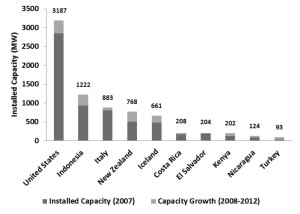Drilling costs at top of economic factors for geothermal projects

By Katie Mazerov, contributing editor
No longer the “forgotten resource,” geothermal energy is seeing double-digit growth globally, while in the US, the decision by Congress to extend the geothermal tax credit combined with efforts to leverage lessons from the oil and gas industry will continue to move geothermal forward, according to a panel of leading experts participating in the International Geothermal Energy Finance Forum on 11 April in New York City.
“The threshold for development of geothermal energy appears to be financial risk and how well proven the resource is,” said Karl Gawell, executive director of the Geothermal Energy Association (GEA), which sponsored the event. Speaking at a media preview to the day-long forum, Mr Gawell noted that roughly half the cost of a geothermal well involves “proving the resource,” with drilling costs having the greatest impact on project economics.
Geothermal wells in the US are typically approximately 10,000 ft deep in hard rock formations at temperatures as high as 700°F, with larger-diameter holes. “Geothermal drilling is much like oil and gas drilling, but more dangerous,” said Fred Rothauge, manager, corporate business development for Hydro Resources, a company specializing in the development and maintenance of large-scale groundwater resources. “Most of what we are currently drilling is shallower and cooler, so it is less risky.”
The oil and gas industry does have several production-enhancing techniques that have yet to be attempted in geothermal production, Mr Gawell continued. “We’re a very small industry, so the first time we use a new technology, it will be a research and development (R&D) project. It has only been in the last few years that the US Department of Energy (DOE) has had a reasonable research budget in this field. We’re now seeing slow but sustained growth in the US, with a strong commitment to technology innovation.”
Going forward, the geothermal community will continue to have a “symbiotic relationship” with the oil and gas industry, said Doug Hollet, director of DOE’s Geothermal Technologies Office. “For example, we’re pushing the same boundaries they’re following as they go into high-pressure, high-temperature environments. We have five significant R&D projects under way now, and we’re also moving toward seeing what we can do with horizontal drilling in geothermal wells. We’ve seen the impact of horizontal drilling in the oil and gas sector. Imagine the impact if we could successfully intersect a sub-vertical fracture structure with horizontal wells.”

Financial incentives, investment
Financing is also critical to geothermal’s future. “In the US, federal policy drives energy markets, and federal tax incentives will provide the geothermal industry with the time it needs to overcome risk associated with project timelines,” Mr Gawell said. “Specifically, geothermal projects will qualify for tax incentives once they are under construction. However, the construction period still needs to be defined. A geothermal project may take seven years from start to finish, including three years for construction.”
At the same time, private capital through the World Bank and other international financial institutions is expanding prospects for geothermal power. “The World Bank is calling on other international and multi-lateral financing institutions to expand support for geothermal power, for which a need of approximately $500 million investment in geothermal efforts would allow the sector to expand on a sustainable basis,” he noted.
More than 70 countries are reported to have 19,000 Megawatts of geothermal power under development, representing a potential investment of approximately $100 billion, tripling geothermal power generation worldwide, Mr Gawell added. Countries leading the effort include the US, Indonesia, Italy, New Zealand, Iceland, Costa Rica, El Salvador, Kenya, Nicaragua, Turkey, the Philippines, Ethiopia, Chile and Japan. Sixteen countries participated in the Finance Forum.
The GEA is made up of US companies that support the expanded use of geothermal energy and are developing geothermal resources worldwide for electrical power generation and direct-heat uses. The organization advocates development and utilization of geothermal resources, encourages R&D to improve technology, provides assistance for the export of geothermal goods and services, compiles statistical data and conducts education and outreach.




